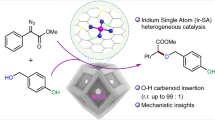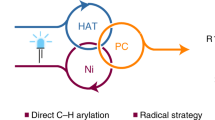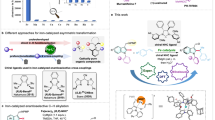Abstract
Catalytic cross-coupling by transition metals has revolutionized the formation of carbon–carbon bonds in organic synthesis. However, the challenge of forming multiple alkyl–alkyl bonds in crowded environments remains largely unresolved. Here we report the regioselective functionalization of olefins with sp3-hybridized organohalides and organozinc reagents using a simple (terpyridine)iron catalyst. Aliphatic groups of various sizes are successfully installed on either olefinic carbon, furnishing a diverse array of products with congested cores featuring carbon- or heteroatom-substituted stereocentres. The method enables access to valuable but synthetically challenging C(sp3)-rich molecules, including alicyclic compounds bearing multiple contiguous stereocentres, through annulation cascades. Mechanistic and theoretical studies suggest a stepwise iron-mediated radical carbometallation pathway followed by outer-sphere carbon–carbon bond formation, which potentially opens the door to a broader scope of transformations and new chemical space.

This is a preview of subscription content, access via your institution
Access options
Access Nature and 54 other Nature Portfolio journals
Get Nature+, our best-value online-access subscription
$29.99 / 30 days
cancel any time
Subscribe to this journal
Receive 12 digital issues and online access to articles
$119.00 per year
only $9.92 per issue
Buy this article
- Purchase on Springer Link
- Instant access to full article PDF
Prices may be subject to local taxes which are calculated during checkout





Similar content being viewed by others
Data availability
DFT-optimized structures, relevant intrinsic reaction coordinate (IRC) and transition state movies and Mulliken spin population analysis files have been uploaded to zenodo.org (https://zenodo.org/records/8174459). All other data are available in the main text or the Supplementary Information, or from the authors upon reasonable request.
References
Geist, E., Kirschning, A. & Schmidt, T. sp3–sp3 coupling reactions in the synthesis of natural products and biologically active molecules. Nat. Prod. Rep. 31, 441–448 (2014).
Lovering, F., Bikker, J. & Humblet, C. Escape from flatland: increasing saturation as an approach to improving clinical success. J. Med. Chem. 52, 6752–6756 (2009).
de Meijere, A. & Diederich, F. Metal-Catalysed Cross-Coupling Reactions (Wiley-VCH, 2004).
Kranthikumar, R. Recent advances in C(sp3)–C(sp3) cross-coupling chemistry: a dominant performance of nickel catalysts. Organometallics 41, 667–679 (2022).
Choi, J. & Fu, G. C. Transition metal-catalysed alkyl–alkyl bond formation: another dimension in cross-coupling chemistry. Science 356, eaaf7230 (2017).
Blakemore, D. C. et al. Organic synthesis provides opportunities to transform drug discovery. Nat. Chem. 10, 383–394 (2018).
Johnston, C. P., Smith, R. T., Allmendinger, S. & MacMillan, D. W. C. Metallaphotoredox-catalysed sp3–sp3 cross-coupling of carboxylic acids with alkyl halides. Nature 536, 322–325 (2016).
Qin, T. et al. A general alkyl–alkyl cross-coupling enabled by redox-active esters and alkylzinc reagents. Science 352, 801–805 (2016).
Zhang, W. et al. Electrochemically driven cross-electrophile coupling of alkyl halides. Nature 604, 292–297 (2022).
Liu, W., Lavagnino, M. N., Gould, C. A., Alcazar, J. & MacMillan, D. W. C. A biomimetic SH2 cross-coupling mechanism for quaternary sp3-carbon formation. Science 374, 1258–1263 (2021).
Wickham, L. & Giri, R. Transition metal (Ni, Cu, Pd)-catalysed alkene dicarbofunctionalization reactions. Acc. Chem. Res. 54, 3415–3437 (2021).
Zhang, L. et al. Catalytic conjunctive cross-coupling enabled by metal-induced metallate rearrangement. Science 351, 70–74 (2016).
Dhungana, R. K. et al. Ni-catalysed regioselective 1,2-dialkylation of alkenes enabled by the formation of two C(sp3)–C(sp3) bonds. J. Am. Chem. Soc. 142, 20930–20936 (2020).
Yang, T. et al. Chemoselective union of olefins, organohalides and redox-active esters enables regioselective alkene dialkylation. J. Am. Chem. Soc. 142, 21410–21419 (2020).
Wang, X.-X., Lu, X., He, S.-J. & Fu, Y. Nickel-catalysed three-component olefin reductive dicarbofunctionalization to access alkylborates. Chem. Sci. 11, 7950–7956 (2020).
Terao, J., Saito, K., Nii, S., Kambe, N. & Sonoda, N. Regioselective double alkylation of styrenes with alkyl halides using a titanocene catalyst. J. Am. Chem. Soc. 120, 11822–11823 (1998).
Mizutani, K., Shinokubo, H. & Oshima, K. Cobalt-catalysed three-component coupling reaction of alkyl halides, 1,3-dienes, and trimethylsilylmethylmagnesium chloride. Org. Lett. 5, 3959–3961 (2003).
Derosa, J., van der Puyl, V. A., Tran, V. T., Liu, M. & Engle, K. M. Directed nickel-catalysed 1,2-dialkylation of alkenyl carbonyl compounds. Chem. Sci. 9, 5278–5283 (2018).
Rana, S., Biswas, J. P., Paul, S., Paik, A. & Maiti, D. Organic synthesis with the most abundant transition metal—iron: from rust to multitasking catalysts. Chem. Soc. Rev. 50, 243–472 (2021).
Piontek, A., Bisz, E. & Szostak, M. Iron-catalysed cross-couplings in the synthesis of pharmaceuticals: in pursuit of sustainability. Angew. Chem. Int. Ed. 57, 11116–11128 (2018).
Bellows, S. M., Cundari, T. R. & Holland, P. L. Spin crossover during β-hydride elimination in high-spin iron(II)- and cobalt(II)-alkyl complexes. Organometallics 32, 4741–4751 (2013).
Liu, L. et al. General method for iron-catalysed multicomponent radical cascades–cross-couplings. Science 374, 432–439 (2021).
Liu, L. et al. Fe-catalysed three-component dicarbofunctionalization of unactivated alkenes with Grignard reagents. Chem. Sci. 11, 8301–8305 (2021).
Rotella, M. E., Sar, D., Liu, L. & Gutierrez, O. Fe-catalysed dicarbofunctionalization of electron-rich alkenes with Grignard reagents and (fluoro)alkyl halides. Chem. Commun. 57, 12508–12511 (2021).
Sklute, G., Cavender, H. & Marek, I. Carbozincation reactions of carbon–carbon multiple bonds. Org. React. 87, 507–763 (2015).
Huang, Q. et al. Iron-catalysed vinylzincation of terminal alkynes. J. Am. Chem. Soc. 144, 515–526 (2022).
Zhang, C. et al. Enantiomerically enriched α-borylzinc reagents by nickel-catalyzed carbozincation of vinylboronic esters. J. Am. Chem. Soc. 143, 14189–14195 (2021).
Ilies, L., Matsubara, T., Ichikawa, S., Asako, S. & Nakamura, E. Iron-catalysed directed alkylation of aromatic and olefinic carboxamides with primary and secondary alkyl tosylates, mesylates, and halides. J. Am. Chem. Soc. 136, 13126–13129 (2014).
Newcomb, M. in Encyclopedia of Radicals in Chemistry, Biology and Materials (eds Chatgilialoglu, C. & Studer, A.) 107–124 (Wiley, 2012).
Yi, X., Mao, R., Lavrencic, L. & Hu, X. Photocatalytic decarboxylative coupling of aliphatic N-hydroxyphthalimide esters with polyfluoroaryl nucleophiles. Angew. Chem. Int. Ed. 60, 23557–23563 (2021).
Eisenberg, D. C. & Norton, J. R. Hydrogen-atom transfer reactions of transition-metal hydrides. Isr. J. Chem. 31, 55–66 (1991).
Waser, J. & Carreira, E. M. Convenient synthesis of alkylhydrazides by the cobalt-catalysed hydrohydrazination reaction of olefins and azodicarboxylates. J. Am. Chem. Soc. 126, 5676–5677 (2004).
Barker, T. J. & Boger, D. L. Fe(III)/NaBH4-mediated free radical hydrofluorination of unactivated alkenes. J. Am. Chem. Soc. 134, 13588–13591 (2012).
Crossley, S. W. M., Obradors, C., Martinez, R. M. & Shenvi, R. Mn-, Fe-, and Co-catalysed radical hydrofunctionalizations of olefins. Chem. Rev. 116, 8912–9000 (2016).
Lo, J. C. et al. Fe-catalysed C–C bond construction from olefins via radicals. J. Am. Chem. Soc. 139, 2484–2503 (2017).
Reiff, W. M., Erickson, N. E. & Baker, W. A. Jr. Mono(2,2′,2′-terpyridine) complexes of iron(II). Inorg. Chem. 8, 2019–2021 (1969).
England, J., Scarborough, C. C., Weyhermüller, T., Sproules, S. & Wieghardt, K. Electronic structures of the electron transfer series [M(bpy)3]n, [M(tpy)2]n, and [Fe(tbpy)3]n (M = Fe, Ru; n = 3+, 2+, 1+, 0, 1−): a Mössbauer spectroscopic and DFT study. Eur. J. Inorg. Chem. 2012, 4605–4621 (2012).
Tondreau, A. M. et al. Synthesis, electronic structure, and alkene hydrosilylation activity of terpyridine and bis(imino)pyridine iron dialkyl complexes. Organometallics 31, 4886–4893 (2012).
Halpern, J. Mechanistic aspects of homogeneous catalytic hydrogenation and related processes. Inorg. Chim. Acta 50, 11–19 (1981).
Kozuch, S. & Shaik, S. How to conceptualize catalytic cycles? The energetic span model. Acc. Chem. Res. 44, 101–110 (2011).
Poli, R. New phenomena in organometallic-mediated radical polymerization (OMRP) and perspectives for control of less active monomers. Chem. Eur. J. 21, 6988–7001 (2015).
Franz, A. K. & Wilson, S. O. Organosilicon molecules with medicinal applications. J. Med. Chem. 56, 388–405 (2013).
Vitaku, E., Smith, D. T. & Njardarson, J. T. Analysis of the structural diversity, substitution patterns, and frequency of nitrogen heterocycles among US FDA-approved pharmaceuticals. J. Med. Chem. 57, 10257–10274 (2014).
Baker, S. J. et al. Therapeutic potential of boron-containing compounds. Future Med. Chem. 1, 1275–1288 (2009).
Shennan, B. D. A. et al. Branching out: redox strategies towards the synthesis of acyclic α-tertiary ethers. Chem. Soc. Rev. 51, 5878–5929 (2022).
Hagmann, W. K. The many roles for fluorine in medicinal chemistry. J. Med. Chem. 51, 4359–4369 (2008).
Fujita, T., Fuchibe, K. & Ichikawa, J. Transition-metal-mediated and -catalysed C–F bond activation by fluorine elimination. Angew. Chem. Int. Ed. 58, 390–402 (2019).
Wang, M. & Casey, P. J. Protein prenylation: unique fats make their mark on biology. Nat. Rev. Mol. Cell Biol. 17, 110–122 (2016).
Iakovenko, R. O. et al. Reactions of CF3-enones with arenes under superelectrophilic activation: a pathway to trans-1,3-diaryl-1-CF3-indanes, new cannabinoid receptor ligands. Org. Biomol. Chem. 13, 8827–8842 (2015).
Begue, J. P. & Bonnet-Delpon, D. Bioorganic and Medicinal Chemistry of Fluorine (Wiley, 2008).
Waibel, M. et al. Bibenzyl- and stilbene-core compounds with non-polar linker atom substituents as selective ligands for estrogen receptor beta. Eur. J. Med. Chem. 44, 3412–3424 (2009).
Gasparyan, N. K., Gevorgyan, G. A., Paronikyan, R. G., Tumadzhyan, A. E. & Panosyan, G. A. Synthesis and biological activity of diaryl-substituted 3-morpholinopropanols. Pharm. Chem. J. 39, 361–363 (2005).
Acknowledgements
This research was supported by the Ministry of Education of Singapore Academic Research Fund Tier 2 (A-8000034-00-00 (M.J.K.)), the Foundation of Wenzhou Science & Technology Bureau (ZY2020027 (T.-D.T. and P.-C.Q.)), the Institute of High Performance Computing and the Deputy Chief Executive Research Office (DCERO) A*STAR Career Development Fund (C210812008 (X.Z.)), the Manufacturing, Trade and Connectivity (MTC) Young Individual Research Grants (M22K3c0091 (X.Z.)) and the National Institutes of Health (GM129081 (P.L.H.)). X.Z. acknowledges the A*STAR Computational Resource Centre (A*CRC) of Singapore for the partial use of its high-performance computing facilities.
Author information
Authors and Affiliations
Contributions
M.J.K. and T.-D.T. conceived the project. T.-D.T., X.L. and P.-C.Q. developed the catalytic method. J.M.I.S. and P.L.H. designed and performed the Mössbauer studies. X.Z. designed and performed the DFT studies. All authors contributed to the writing of the manuscript.
Corresponding authors
Ethics declarations
Competing interests
The authors declare no competing interests.
Peer review
Peer review information
Nature Catalysis thanks Kumar Vanka and the other, anonymous, reviewer(s) for their contribution to the peer review of this work.
Additional information
Publisher’s note Springer Nature remains neutral with regard to jurisdictional claims in published maps and institutional affiliations.
Supplementary information
Supplementary Information
Supplementary Tables 1–9, Figs. 1–43, Methods and References.
Rights and permissions
Springer Nature or its licensor (e.g. a society or other partner) holds exclusive rights to this article under a publishing agreement with the author(s) or other rightsholder(s); author self-archiving of the accepted manuscript version of this article is solely governed by the terms of such publishing agreement and applicable law.
About this article
Cite this article
Tan, TD., Serviano, J.M.I., Luo, X. et al. Congested C(sp3)-rich architectures enabled by iron-catalysed conjunctive alkylation. Nat Catal 7, 321–329 (2024). https://doi.org/10.1038/s41929-024-01113-8
Received:
Accepted:
Published:
Issue Date:
DOI: https://doi.org/10.1038/s41929-024-01113-8



